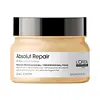L'Oréal Professionnel Absolut Repair Protein Treatment Hair Mask Versus L'Oreal Elvive Extraordinary Oil Hair Mask
What's inside
What's inside
 Key Ingredients
Key Ingredients

No key ingredients
 Benefits
Benefits

 Concerns
Concerns

 Ingredients Side-by-side
Ingredients Side-by-side

Water
Skin ConditioningCetearyl Alcohol
EmollientBehentrimonium Chloride
PreservativeCandelilla Cera
EmollientAmodimethicone
Cetyl Esters
EmollientIsopropyl Alcohol
SolventGlycerin
HumectantPhenoxyethanol
PreservativeTrideceth-6
EmulsifyingLinalool
PerfumingLactic Acid
BufferingHexyl Cinnamal
PerfumingChlorhexidine Digluconate
AntimicrobialCetrimonium Chloride
AntimicrobialLimonene
PerfumingSodium Hydroxide
BufferingChenopodium Quinoa Seed Extract
Skin ConditioningHydroxypropyltrimonium Hydrolyzed Wheat Protein
Skin ConditioningCI 19140
Cosmetic ColorantCI 15985
Cosmetic ColorantParfum
MaskingWater, Cetearyl Alcohol, Behentrimonium Chloride, Candelilla Cera, Amodimethicone, Cetyl Esters, Isopropyl Alcohol, Glycerin, Phenoxyethanol, Trideceth-6, Linalool, Lactic Acid, Hexyl Cinnamal, Chlorhexidine Digluconate, Cetrimonium Chloride, Limonene, Sodium Hydroxide, Chenopodium Quinoa Seed Extract, Hydroxypropyltrimonium Hydrolyzed Wheat Protein, CI 19140, CI 15985, Parfum
Water
Skin ConditioningCetearyl Alcohol
EmollientParaffinum Liquidum
EmollientDipalmitoylethyl Hydroxyethylmonium Methosulfate
Cetyl Esters
EmollientCI 77891
Cosmetic ColorantCI 77491
Cosmetic ColorantCI 15985
Cosmetic ColorantCI 19140
Cosmetic ColorantChamomilla Recutita Extract
Skin ConditioningMica
Cosmetic ColorantCocos Nucifera Oil
MaskingTrideceth-6
EmulsifyingChlorhexidine Digluconate
AntimicrobialHelianthus Annuus Seed Oil
EmollientLinum Usitatissimum Flower Extract
Skin ConditioningAmodimethicone
Caprylyl Glycol
EmollientCaprylic/Capric Triglyceride
MaskingCaramel
Cosmetic ColorantGardenia Taitensis Flower Extract
Skin ConditioningRosa Canina Flower Extract
AstringentBisabolol
MaskingCetrimonium Chloride
AntimicrobialBHT
AntioxidantCitric Acid
BufferingGlycine Soja Oil
EmollientParfum
MaskingWater, Cetearyl Alcohol, Paraffinum Liquidum, Dipalmitoylethyl Hydroxyethylmonium Methosulfate, Cetyl Esters, CI 77891, CI 77491, CI 15985, CI 19140, Chamomilla Recutita Extract, Mica, Cocos Nucifera Oil, Trideceth-6, Chlorhexidine Digluconate, Helianthus Annuus Seed Oil, Linum Usitatissimum Flower Extract, Amodimethicone, Caprylyl Glycol, Caprylic/Capric Triglyceride, Caramel, Gardenia Taitensis Flower Extract, Rosa Canina Flower Extract, Bisabolol, Cetrimonium Chloride, BHT, Citric Acid, Glycine Soja Oil, Parfum
 Reviews
Reviews

Ingredients Explained
These ingredients are found in both products.
Ingredients higher up in an ingredient list are typically present in a larger amount.
This water-soluble silicone is used for its hydrating and softening properties. It is used to add a silky feel to skincare products and has great benefits for haircare.
In haircare, this ingredient:
- Adds shine
- Protects color
- Offers thermal protection
- Boosts hair strength
- Does not build up as easily
Cetearyl alcohol is a mixture of two fatty alcohols: cetyl alcohol and stearyl alcohol. It is mainly used as an emulsifier. Emulsifiers help prevent the separation of oils and products. Due to its composition, it can also be used to thicken a product or help create foam.
Cetearyl alcohol is an emollient. Emollients help soothe and hydrate the skin by trapping moisture.
Studies show Cetearyl alcohol is non-toxic and non-irritating. The FDA allows products labeled "alcohol-free" to have fatty alcohols.
This ingredient is usually derived from plant oils such as palm, vegetable, or coconut oils. There is debate on whether this ingredient will cause acne.
Due to the fatty acid base, this ingredient may not be Malassezia folliculitis safe.
Learn more about Cetearyl AlcoholThis ingredient is a preservative, antimicrobial, and emulsifier. It is often used in cosmetics for its ability to cleanse, condition, and reduce static.
Cetrimonium chloride is a quaternary ammonium salt, meaning it has a water-soluble structure.
Cetyl Esters is a synthetic wax made up of mostly fatty acids and fatty alcohols. It is strcturally similar to wax taken from whales.
As an emollient, it creates a thin barrier on the skin. This barrier prevents moisture from escaping.
This ingredient may not be fungal-acne safe.
Learn more about Cetyl EstersChlorhexidine Digluconate is a preservative.
Ci 15985 is a dye made from petroleum. It is synthetically created and approved by the FDA for use in foods and cosmetics.
The color of this dye is orange/yellow.
This ingredient can be found in makeup, sun care, and skincare.
Learn more about CI 15985CI 19140 is also known as Tartrazine. Tartrazine is a synthetic dye used in cosmetics, foods, and medicine to add a yellow color.
Tartrazine is created from petroleum and is water-soluble.
Some people may experience allergies from this dye, especially asthmatics and those with an aspirin intolerance.
Learn more about CI 19140Parfum is a catch-all term for an ingredient or more that is used to give a scent to products.
Also called "fragrance", this ingredient can be a blend of hundreds of chemicals or plant oils. This means every product with "fragrance" or "parfum" in the ingredients list is a different mixture.
For instance, Habanolide is a proprietary trade name for a specific aroma chemical. When used as a fragrance ingredient in cosmetics, most aroma chemicals fall under the broad labeling category of “FRAGRANCE” or “PARFUM” according to EU and US regulations.
The term 'parfum' or 'fragrance' is not regulated in many countries. In many cases, it is up to the brand to define this term.
For instance, many brands choose to label themselves as "fragrance-free" because they are not using synthetic fragrances. However, their products may still contain ingredients such as essential oils that are considered a fragrance by INCI standards.
One example is Calendula flower extract. Calendula is an essential oil that still imparts a scent or 'fragrance'.
Depending on the blend, the ingredients in the mixture can cause allergies and sensitivities on the skin. Some ingredients that are known EU allergens include linalool and citronellol.
Parfum can also be used to mask or cover an unpleasant scent.
The bottom line is: not all fragrances/parfum/ingredients are created equally. If you are worried about fragrances, we recommend taking a closer look at an ingredient. And of course, we always recommend speaking with a professional.
Learn more about ParfumWe don't have a description for Trideceth-6 yet.
Water. It's the most common cosmetic ingredient of all. You'll usually see it at the top of ingredient lists, meaning that it makes up the largest part of the product.
So why is it so popular? Water most often acts as a solvent - this means that it helps dissolve other ingredients into the formulation.
You'll also recognize water as that liquid we all need to stay alive. If you see this, drink a glass of water. Stay hydrated!
Learn more about Water